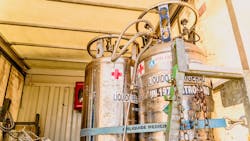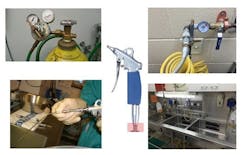Q: “We recently had a consultant come in and tell us we need nitrogen compressed air in prep/pack to blow out cannulas. I have never heard this before. I only know about medical instrument air. Any insight?”
A:
First, any time a consultant/surveyor tells you to change your practice, you have the right to address them (in a positive way) to ask for specific standards or guidelines they are citing. Once you know, then you can determine whether your department needs to comply.
To answer your question: generally yes, with an explanation. Nitrogen has been used for power equipment for as long as I have been in the Sterile Processing industry. Since nitrogen is a very dry gas, it is great when it comes to powered equipment. What about being used for drying?
ANSI/AAMI ST79 states, “2.56 instrument air: Medical gas that falls under the general requirements for medical gases as defined by NFPA® 99 (Health care facilities code), is not respired, is compliant with the ANSI/ISA 7.0.01 (Quality standard for instrument air).”1
The next step is to understand NFPA® 99-2018. How are medical gases defined, and does the definition address instrument air and nitrogen? Instrument air and nitrogen can be found under section 3.3.107 Medical Support Gas, which states, “Nitrogen or instrument air used for any medical support purpose (e.g., to remove excess moisture from instruments before further processing, or to operate medical–surgical tools, air-driven booms, pendants, or similar applications) and, if appropriate to the procedures, used in laboratories and are not respired as part of any treatment. Medical support gas falls under the general requirements for medical gases. (PIP)”2
To complete the research, another section that must be reviewed is section “3.3.102* Medical Air. For purposes of this code, medical air is air supplied from cylinders, bulk containers, or medical air compressors, or reconstituted from oxygen USP and oil-free, dry nitrogen NF. (PIP)”3
Personally, I would say Yes to the question posed above with these caveats. I would request your manager to ask the consultant to state where they gained the information to make such a statement, and not just take their word for it. Nitrogen can meet the parameters set out in the NFPA® 99-2018, based on my research, and each department must come to their own conclusion about what type of medical air/medical support gases they want to use in their department. I also recommend documenting why and have that documentation available in case you are asked for it.
In closing, a few important points need to be made about using gases in the department.
- Regulate the flow of gas that you use–this is a safety issue.
- Train your staff to use the gas and drying medical devices properly (e.g., wearing appropriate safety equipment such as safety glasses), and document the training.
- If using standalone tanks, they must be secured in the department according to Occupational Safety and Health Administration (OSHA) standards.
- Have documentation and a policy on why you are using that specific type of gas in your department.
- Review your IFU to ensure you are meeting the requirements for drying medical devices used in your department.
References:
1. AAMI (2020). ANSI/AAMI ST79:2017 Comprehensive guide to steam sterilization and sterility assurance in health care facilities [2.56 Instrument Air], Amendment A.2 (2020). Arlington, VA: Association for the Advancement of Medical Instrumentation.
2. NFPA® (2017, September 6). NFPA® 99-2018, Health Care Facilities Code 2018 Ed [3.3.107 Medical Support Gas]. Quincy, MA: National Fire Protection Association. https://edufire.ir/storage/Library/other/NFPA®%2099-2018.pdf
3. NFPA® (2017, September 6). NFPA® 99-2018, Health Care Facilities Code 2018 Ed [3.3.102* Medical Air]. Quincy, MA: National Fire Protection Association. https://edufire.ir/storage/Library/other/NFPA%2099-2018.pdf
About the Author

Stephen M. Kovach
Stephen M Kovach, BS, CFER, started in the medical field in 1975 as a sterilization orderly and has worked in many positions within the Healthcare Industry. He presently is Clinical Educator Emeritus at Healthmark, A Getinge company.

